I've searched BYC and don't see alot of info on Road Island Red, let alone RIR rooster. Show your RIR roo pictures and your experience with the Breed!
Navigation
Install the app
How to install the app on iOS
Follow along with the video below to see how to install our site as a web app on your home screen.
Note: This feature may not be available in some browsers.
More options
You are using an out of date browser. It may not display this or other websites correctly.
You should upgrade or use an alternative browser.
You should upgrade or use an alternative browser.
Show off your RIR Rooster!
- Thread starter Domestic_goddess
- Start date
More options
Who Replied?Domestic_goddess --
I'm not sure what information you wanted to know about the Rhode Island Red but here is the Rhode Island Red Thread.
https://www.backyardchickens.com/forum/viewtopic.php?id=283534
Here is some information that I wrought on there from what I have found here and there on the net.
The Rhode Island Reds origin can be dated back to the middle 1840s and one of the oldest breed of chicken to be developed in America.
The States of Rhode Island and Massachusetts should get the most credit for the development of the
Rhode Island Red breed. Poultry farmers in the area wanted a breed of hen that would produce a good amount of eggs a year and still dress out nice as a meat breed. Some of the breed of poultry that was used to produce the Rhode Island Red seem to be unclear. The American Standard of Perfection says that it was the crossing of the Red Malay, Leghorn and native Asiatic fowl,
wile the founders of the Rhode Island Red Club say that it was the crossing of the
Red Chittagong (Red Brahmas), Cochin, Red Shanghai, Black Breasted Malay and the Red Malay.
Some breeders believe the Dark Brown Leghorn may have also been added to raise the egg productivity.
Historians believe that a man by the name Captain Richard Wheatland that lived in Rhode Island around 1846 is the person responsible for the rich red color of the Rhode Island Red we see today.
The early Rhode Island Red sported three types of combs, two of which we still have today.
The first is the Pea comb that may owe its pea comb to the Chittagong, second the Single comb that got its comb from the Cochin and the third is the Rose comb that received its combed from the Shanghai.
Many breeds of poultry owe there heritage to the Rhode Island Red, breeds like the New Hampshire and the some lines of Production Reds where bread solely from the Rhode Island Red with no record of outside blood being introduced. Rhode Island Reds also has been used in crosses to produce hybrid breeds such as the Red and Black Sex-Links and some breeder believe a second line of Production Red was produced by introducing Leghorn blood into the Rhode Island Red.
In 1954 the governor of Rhode Island signed into law that the Rhode Island Red chicken would be the state bird of Rhode Island.
The Rhode Island Red color pattern is a modified Columbian color pattern that may have came from the Brahma blood that was used in the making of this breed.
The first modification to the Columbian color pattern in the development of the Rhode Island Red was to replace the white with red. Note that in the American Standard of Perfection, it says any bird with a entirely white feather showing in the surface is a disqualification. The second modification was to remove the black pigmentation from all but the wing and tail in the male; and the same for the female with some black ticking remaining at the base of her hackles almost like a necklace. At the end what we have is a Rhode Island Red that has become entirely a rich red with black pigmentation left only in the tail and on one side of the wing feathers and some black ticking remaining at the base of the hens hackles.
This is a description of the color in Rhode Island Reds that I found on a Red site I was on. It is about using a corncob pipe for an example. He said that leg and beak color should resemble the color of the bowl and mouthpiece of the pipe. The shade or depth of the horn color you want is that of a well-used old-time corncob pipe. The true under color matches the color of a pack of Prince Albert pipe tobacco. If slate or smut is used, it should be the color of a totally smoked bowl of tobacco. In the vegetable section of the grocery store, is where you will find the true quill color and that is the dark blood-red shade of Binge Cherries.
The Standard for the R.I. Reds
Economic Qualities-
Rhode Island Reds are general purpose fowls bred for the production of meat and eggs. Color of skin, yellow; color of egg shells, brown to dark brown.
Standard Weight-
Cock 8 ½ lbs Hens 6 ½
Cockerel 7 ½ lbs Pullets .5 ½
Shape Male-
Comb: Single, moderately large, set firmly on head, straight and upright, with five even and well defined points, those in front and rear smaller than those in the Center: blade smooth inclining slightly downward following contour of the skull.
Comb: Rose , moderately large, firm on head ; oval, free from hollow center, surface covered with small rounded points, terminating in a spike at the rear, the spike drooping slightly but not conforming too closely to the shape of head.
Beak: Medium length, slightly curved.
Face: Clean cut, skin fine and soft in texture, free from wrinkles.
Eyes: large, full and prominent.
Wattles: Medium size, uniform, free from folds or wrinkles.
Ear Lobes: Oblong, well defined, smooth.
Head: Medium in length, fairly deep, inclined to be flat on the top rather than round.
Neck: Medium length.
Hackle: Abundant, flowing over shoulders, not too closely feathered.
Back: Long, moderately broad its entire length, carried horizontally.
Saddle: moderately broad, feathers of medium length, moderately abundant, blending into tail.
Tail: Medium length, well spread carried at an angle of twenty degrees (20*) above horizontal.
Main Tail: broad and overlapping.
Main Sickles: medium length, broad, extending slightly beyond mail tail feathers.
Lesser Sickles and Tail-Coverts: medium length, broad and overlapping
Wings: Good size, well folded, carried horizontally.
Primaries and Secondarys broad and overlapping in natural order when wing is folded.
Breast: Moderately deep, full, well rounded.
Body and Fluff: Body long, broad, moderately deep, straight, extending well forward, giving the body an OBLONG appearance feathers, carried close to body.
Fluff: moderately full.
Legs and toes: Legs set well apart, straight when viewed from front.
Lower Thighs: medium length, well feathered, smooth.
Shanks: medium length, smooth.
Toes: four on each foot, medium length, and straight, well spread.
Shape Female-
Comb: Single; medium in size, set firmly on head, straight and upright with five even and well defined points, those in front and rear smaller than those in center.
Comb: Rose low free from hollow center, set firmly on head, much smaller than that of the male and in proportion to its length, narrower covered with small points and terminating in a small, short spike at the rear.
Beak: Medium length slightly curved.
Face: Clean cut, skin,, fine and soft in texture, free from wrinkles.
Eyes: large, full, and prominent.
Wattles: Medium size, regularly curved.
Ear Lobes: Oblong, well defined, smooth.
Head: Medium in length, fairly deep, inclined to be flat on top rather round.
Neck: Medium length, moderately full feathered.
Back: Long, moderately broad its entire length, carried horizontally, blending into tail.
Tail: Medium length well spread, carried at an angle of ten degrees (10*) above horizontal.
Wings: Rather large, well folded.
Fronts: well covered by breast feathers
Flights: carried nearly horizontally.
Primaries and Secondarys: broad and overlapping in natural order when wing is folded.
Breast: Moderately, deep, full, well rounded.
Body and Fluff: Body long, moderately broad, moderately deep, straight, extending well forward, giving the body an OBLONG appearance feathers, carried close to body.
Fluff: moderately full.
Legs and toes: Legs set well apart, straight when viewed and front.
Lower Thighs: medium length, well feathered, smooth. Shanks; medium length, smooth.
Toes: four on each foot, medium length, and straight, well spread.
Color Male-
Comb, face, wattles and ear lobes: Bright red.
Beak: Reddish horn.
Eyes: Reddish bay.
Head: Plumage, lustrous rich dark red.
Neck: Hackle lustrous, rich dark red.
Front of neck: rich dark red.
Back and Saddle: lustrous, rich, dark red.
Tail: Main Tail: black
Sickles: lustrous, greenish black. Beetle Green.
Coverts: mainly lustrous, greenish black, rich red as they approach the saddle.
Wings: Fronts, Bows and Coverts lustrous, rich dark red.
Primaries: upper webs, lustrous , rich dark red lower webs, black with narrow edging of red.
Secondarys: lower webs, lustrous, rich, dark red, the red extending around end of feathers sufficient to secure a red wing bay and lacing the upper portion of the upper web, this color growing wider in shorter secondarys remainder of each secondary black feathers next to the body being red on surface so that the wing when folded in natural position shall show one harmonious lustrous, rich, dark red color.
Breast: Lustrous, rich, dark red.
Body and Fluff: Body lustrous , rich dark red.
Fluff: Rich dark red.
Legs and toes: Lower thighs rich, dark red.
Shanks and toes: Rich yellow tinged with reddish horn. A line of red pigment down the sides of shanks, extending to tips of toes, is desirable.
Undercolor of all sections: Rich intense Red.
Plumage: General surface color, lustrous, rich dark red, except where black is specified and free from and shafting or mealiness. No contrast in color between any of the sections, the harmonious blending in all sections desired. The specimen should carry a high sheen in all outer sections so as to give a glossed appearance.
Color of Female-
Comb, Face, Wattles and ear lobes: bright Red.
Beak: Reddish horn.
Eyes: Reddish bay.
Head: Plumage lustrous rich dark red.
Neck; Lustrous, rich dark red with slight ticking of black, confined to tips of lower neck feathers.
Front of neck: Rich dark red.
Back: Lustrous, rich dark red.
Tail: Main tail Black.
Wings: Fronts, Bows and Coverts lustrous, rich, dark red.
Primaries: upper webs, lustrous, rich dark red lower webs, black with narrow edging of red.
Secondaries: lower webs, lustrous, rich, dark red, the red extending around end of feathers sufficient to secure a red wing bay and facing the upper portion of the upper web, this color growing wider in shorter secondaries remainder of each secondary black feathers next to body being red on surface so the wing when folded in natural position shall show on harmonious lustrous, rich dark red color.
Breast: lustrous, rich dark red.
Body and Fluff: body lustrous, rich, dark red. Fluff rich dark red.
Legs and toes: Lower thighs rich dark red. Shanks and toes rich yellow tinged with reddish horn.
Under color of all sections: Rich intense red.
Plumage General surface color, lustrous, rich dark red, except where black is specified, even in all sections and free from shafting or mealiness.
Disqualifications-
One or more entirely white feathers showing in the outer plumage.
R.I. Reds should carry its body perfectly horizontal and should be long, approaching in shape when viewed from the side as nearly as possible to rectangle or Brick Shape. The line of back and keel should be both be level and parallel to one another. The base line of the wing should be parallel to the back and keel and the wing should never have a tendency to drop, as the is a defect. The back should not only be flat from front to rear, but should be flat side to side. There should be no tendency to slope from the backbone to the side, and show no indication of a ridge along the backbone. The breast must project outward in order to fill out the rectangular shape. If a line was dropped through the base of the beak it should just clear the front of the breast. The tail should be well spread and carried what would be considered low at 20* for males and 10* for females, and should not be drooping.
A red eye in R.I. Reds is very desirable in the breeders of both males and females.
However, a male good in other traits should not be discarded as a breeder if his eye is bright, healthy and on the bay order. A hens eye color will tend to fade with laying, and it is rather hard to find good eyes in a old hen. However, a hen has a bright, healthy bay color eye probably had a strong eye as a pullet and can be used as a breeder.
The beak on breeders should be reddish horn in color. A beak that is dark black and streaky is not desired and should be selected against.
Breeders should have red ear lobes and birds showing white in there ear lobes is not desired and should be selected against.
In breeding R. I. Reds a double mating is often used especially for the sake of color. However it is unnecessary with proper selection of breeders. To avoid the double mating, do not use a the extremely dark males, as the females from them can often be poor in color and tending to be mottled.
The mating should consist of a rich color male with even shade in hackle, wing bows, back and saddle.
The females should be dark, rich and even in color. Hens color should also be lustrous, bright, alive and not a flat, dead color which shows as brown or chocolate color.
Birds of even color are especially desired as breeding stock. The females that are to be used in the mating should not show too much black in the hackles and wing. In fact, hens that are free from black ticking in the hackle and wings in which the black markings are faint are preferred as the males with dark black markings in the wing will give about the right amount of ticking in the pullets hackles. If the black is dark in both males and females then there is a tendency to produce black lacing in the hackles of the male offspring.
Rose Comb R.I. Red Rooster



Rose Comb R.I. Red Cockerel

Single Comb R.I. Red Cockerel

R.I. Red Cockerel Eye Color

Chris
I'm not sure what information you wanted to know about the Rhode Island Red but here is the Rhode Island Red Thread.
https://www.backyardchickens.com/forum/viewtopic.php?id=283534
Here is some information that I wrought on there from what I have found here and there on the net.
The Rhode Island Reds origin can be dated back to the middle 1840s and one of the oldest breed of chicken to be developed in America.
The States of Rhode Island and Massachusetts should get the most credit for the development of the
Rhode Island Red breed. Poultry farmers in the area wanted a breed of hen that would produce a good amount of eggs a year and still dress out nice as a meat breed. Some of the breed of poultry that was used to produce the Rhode Island Red seem to be unclear. The American Standard of Perfection says that it was the crossing of the Red Malay, Leghorn and native Asiatic fowl,
wile the founders of the Rhode Island Red Club say that it was the crossing of the
Red Chittagong (Red Brahmas), Cochin, Red Shanghai, Black Breasted Malay and the Red Malay.
Some breeders believe the Dark Brown Leghorn may have also been added to raise the egg productivity.
Historians believe that a man by the name Captain Richard Wheatland that lived in Rhode Island around 1846 is the person responsible for the rich red color of the Rhode Island Red we see today.
The early Rhode Island Red sported three types of combs, two of which we still have today.
The first is the Pea comb that may owe its pea comb to the Chittagong, second the Single comb that got its comb from the Cochin and the third is the Rose comb that received its combed from the Shanghai.
Many breeds of poultry owe there heritage to the Rhode Island Red, breeds like the New Hampshire and the some lines of Production Reds where bread solely from the Rhode Island Red with no record of outside blood being introduced. Rhode Island Reds also has been used in crosses to produce hybrid breeds such as the Red and Black Sex-Links and some breeder believe a second line of Production Red was produced by introducing Leghorn blood into the Rhode Island Red.
In 1954 the governor of Rhode Island signed into law that the Rhode Island Red chicken would be the state bird of Rhode Island.
The Rhode Island Red color pattern is a modified Columbian color pattern that may have came from the Brahma blood that was used in the making of this breed.
The first modification to the Columbian color pattern in the development of the Rhode Island Red was to replace the white with red. Note that in the American Standard of Perfection, it says any bird with a entirely white feather showing in the surface is a disqualification. The second modification was to remove the black pigmentation from all but the wing and tail in the male; and the same for the female with some black ticking remaining at the base of her hackles almost like a necklace. At the end what we have is a Rhode Island Red that has become entirely a rich red with black pigmentation left only in the tail and on one side of the wing feathers and some black ticking remaining at the base of the hens hackles.
This is a description of the color in Rhode Island Reds that I found on a Red site I was on. It is about using a corncob pipe for an example. He said that leg and beak color should resemble the color of the bowl and mouthpiece of the pipe. The shade or depth of the horn color you want is that of a well-used old-time corncob pipe. The true under color matches the color of a pack of Prince Albert pipe tobacco. If slate or smut is used, it should be the color of a totally smoked bowl of tobacco. In the vegetable section of the grocery store, is where you will find the true quill color and that is the dark blood-red shade of Binge Cherries.
The Standard for the R.I. Reds
Economic Qualities-
Rhode Island Reds are general purpose fowls bred for the production of meat and eggs. Color of skin, yellow; color of egg shells, brown to dark brown.
Standard Weight-
Cock 8 ½ lbs Hens 6 ½
Cockerel 7 ½ lbs Pullets .5 ½
Shape Male-
Comb: Single, moderately large, set firmly on head, straight and upright, with five even and well defined points, those in front and rear smaller than those in the Center: blade smooth inclining slightly downward following contour of the skull.
Comb: Rose , moderately large, firm on head ; oval, free from hollow center, surface covered with small rounded points, terminating in a spike at the rear, the spike drooping slightly but not conforming too closely to the shape of head.
Beak: Medium length, slightly curved.
Face: Clean cut, skin fine and soft in texture, free from wrinkles.
Eyes: large, full and prominent.
Wattles: Medium size, uniform, free from folds or wrinkles.
Ear Lobes: Oblong, well defined, smooth.
Head: Medium in length, fairly deep, inclined to be flat on the top rather than round.
Neck: Medium length.
Hackle: Abundant, flowing over shoulders, not too closely feathered.
Back: Long, moderately broad its entire length, carried horizontally.
Saddle: moderately broad, feathers of medium length, moderately abundant, blending into tail.
Tail: Medium length, well spread carried at an angle of twenty degrees (20*) above horizontal.
Main Tail: broad and overlapping.
Main Sickles: medium length, broad, extending slightly beyond mail tail feathers.
Lesser Sickles and Tail-Coverts: medium length, broad and overlapping
Wings: Good size, well folded, carried horizontally.
Primaries and Secondarys broad and overlapping in natural order when wing is folded.
Breast: Moderately deep, full, well rounded.
Body and Fluff: Body long, broad, moderately deep, straight, extending well forward, giving the body an OBLONG appearance feathers, carried close to body.
Fluff: moderately full.
Legs and toes: Legs set well apart, straight when viewed from front.
Lower Thighs: medium length, well feathered, smooth.
Shanks: medium length, smooth.
Toes: four on each foot, medium length, and straight, well spread.
Shape Female-
Comb: Single; medium in size, set firmly on head, straight and upright with five even and well defined points, those in front and rear smaller than those in center.
Comb: Rose low free from hollow center, set firmly on head, much smaller than that of the male and in proportion to its length, narrower covered with small points and terminating in a small, short spike at the rear.
Beak: Medium length slightly curved.
Face: Clean cut, skin,, fine and soft in texture, free from wrinkles.
Eyes: large, full, and prominent.
Wattles: Medium size, regularly curved.
Ear Lobes: Oblong, well defined, smooth.
Head: Medium in length, fairly deep, inclined to be flat on top rather round.
Neck: Medium length, moderately full feathered.
Back: Long, moderately broad its entire length, carried horizontally, blending into tail.
Tail: Medium length well spread, carried at an angle of ten degrees (10*) above horizontal.
Wings: Rather large, well folded.
Fronts: well covered by breast feathers
Flights: carried nearly horizontally.
Primaries and Secondarys: broad and overlapping in natural order when wing is folded.
Breast: Moderately, deep, full, well rounded.
Body and Fluff: Body long, moderately broad, moderately deep, straight, extending well forward, giving the body an OBLONG appearance feathers, carried close to body.
Fluff: moderately full.
Legs and toes: Legs set well apart, straight when viewed and front.
Lower Thighs: medium length, well feathered, smooth. Shanks; medium length, smooth.
Toes: four on each foot, medium length, and straight, well spread.
Color Male-
Comb, face, wattles and ear lobes: Bright red.
Beak: Reddish horn.
Eyes: Reddish bay.
Head: Plumage, lustrous rich dark red.
Neck: Hackle lustrous, rich dark red.
Front of neck: rich dark red.
Back and Saddle: lustrous, rich, dark red.
Tail: Main Tail: black
Sickles: lustrous, greenish black. Beetle Green.
Coverts: mainly lustrous, greenish black, rich red as they approach the saddle.
Wings: Fronts, Bows and Coverts lustrous, rich dark red.
Primaries: upper webs, lustrous , rich dark red lower webs, black with narrow edging of red.
Secondarys: lower webs, lustrous, rich, dark red, the red extending around end of feathers sufficient to secure a red wing bay and lacing the upper portion of the upper web, this color growing wider in shorter secondarys remainder of each secondary black feathers next to the body being red on surface so that the wing when folded in natural position shall show one harmonious lustrous, rich, dark red color.
Breast: Lustrous, rich, dark red.
Body and Fluff: Body lustrous , rich dark red.
Fluff: Rich dark red.
Legs and toes: Lower thighs rich, dark red.
Shanks and toes: Rich yellow tinged with reddish horn. A line of red pigment down the sides of shanks, extending to tips of toes, is desirable.
Undercolor of all sections: Rich intense Red.
Plumage: General surface color, lustrous, rich dark red, except where black is specified and free from and shafting or mealiness. No contrast in color between any of the sections, the harmonious blending in all sections desired. The specimen should carry a high sheen in all outer sections so as to give a glossed appearance.
Color of Female-
Comb, Face, Wattles and ear lobes: bright Red.
Beak: Reddish horn.
Eyes: Reddish bay.
Head: Plumage lustrous rich dark red.
Neck; Lustrous, rich dark red with slight ticking of black, confined to tips of lower neck feathers.
Front of neck: Rich dark red.
Back: Lustrous, rich dark red.
Tail: Main tail Black.
Wings: Fronts, Bows and Coverts lustrous, rich, dark red.
Primaries: upper webs, lustrous, rich dark red lower webs, black with narrow edging of red.
Secondaries: lower webs, lustrous, rich, dark red, the red extending around end of feathers sufficient to secure a red wing bay and facing the upper portion of the upper web, this color growing wider in shorter secondaries remainder of each secondary black feathers next to body being red on surface so the wing when folded in natural position shall show on harmonious lustrous, rich dark red color.
Breast: lustrous, rich dark red.
Body and Fluff: body lustrous, rich, dark red. Fluff rich dark red.
Legs and toes: Lower thighs rich dark red. Shanks and toes rich yellow tinged with reddish horn.
Under color of all sections: Rich intense red.
Plumage General surface color, lustrous, rich dark red, except where black is specified, even in all sections and free from shafting or mealiness.
Disqualifications-
One or more entirely white feathers showing in the outer plumage.
R.I. Reds should carry its body perfectly horizontal and should be long, approaching in shape when viewed from the side as nearly as possible to rectangle or Brick Shape. The line of back and keel should be both be level and parallel to one another. The base line of the wing should be parallel to the back and keel and the wing should never have a tendency to drop, as the is a defect. The back should not only be flat from front to rear, but should be flat side to side. There should be no tendency to slope from the backbone to the side, and show no indication of a ridge along the backbone. The breast must project outward in order to fill out the rectangular shape. If a line was dropped through the base of the beak it should just clear the front of the breast. The tail should be well spread and carried what would be considered low at 20* for males and 10* for females, and should not be drooping.
A red eye in R.I. Reds is very desirable in the breeders of both males and females.
However, a male good in other traits should not be discarded as a breeder if his eye is bright, healthy and on the bay order. A hens eye color will tend to fade with laying, and it is rather hard to find good eyes in a old hen. However, a hen has a bright, healthy bay color eye probably had a strong eye as a pullet and can be used as a breeder.
The beak on breeders should be reddish horn in color. A beak that is dark black and streaky is not desired and should be selected against.
Breeders should have red ear lobes and birds showing white in there ear lobes is not desired and should be selected against.
In breeding R. I. Reds a double mating is often used especially for the sake of color. However it is unnecessary with proper selection of breeders. To avoid the double mating, do not use a the extremely dark males, as the females from them can often be poor in color and tending to be mottled.
The mating should consist of a rich color male with even shade in hackle, wing bows, back and saddle.
The females should be dark, rich and even in color. Hens color should also be lustrous, bright, alive and not a flat, dead color which shows as brown or chocolate color.
Birds of even color are especially desired as breeding stock. The females that are to be used in the mating should not show too much black in the hackles and wing. In fact, hens that are free from black ticking in the hackle and wings in which the black markings are faint are preferred as the males with dark black markings in the wing will give about the right amount of ticking in the pullets hackles. If the black is dark in both males and females then there is a tendency to produce black lacing in the hackles of the male offspring.
Rose Comb R.I. Red Rooster
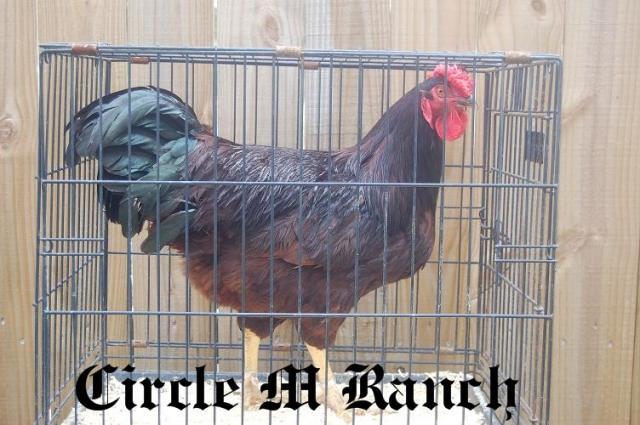
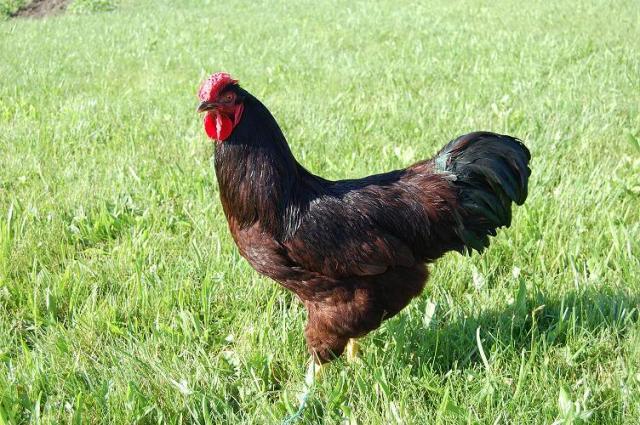
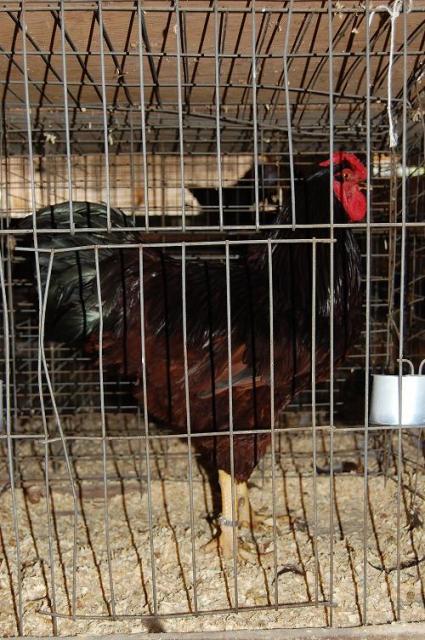
Rose Comb R.I. Red Cockerel
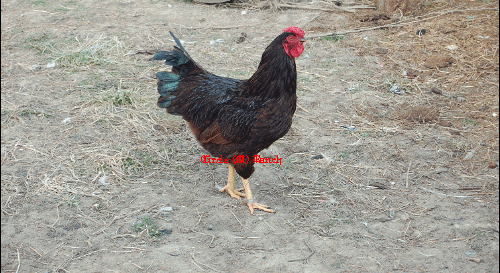
Single Comb R.I. Red Cockerel
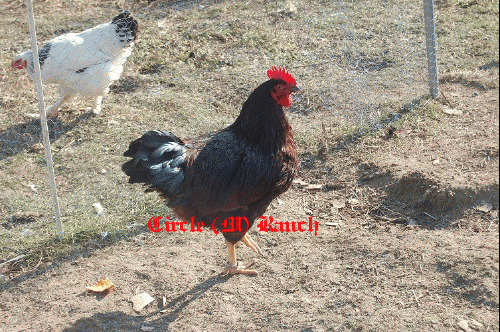
R.I. Red Cockerel Eye Color
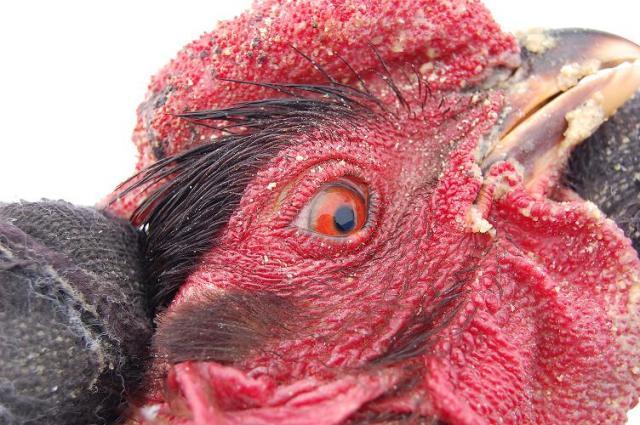
Chris
I think Chris covered just about everything you would want to know. My avatar is a rose comb Rhode Island Red roo.
- Thread starter
- #5
Thank you very much!
Chris, I don't "think" you covered just about everything. I know you covered everything.
 Seriously, you do put out alot of very good info, appreciate it.
Seriously, you do put out alot of very good info, appreciate it.

New posts New threads Active threads
-
Latest threads
-
*GRAPHIC* Necropsy of 16wk old cockerel - Need help with interpereting photos
- Started by Chibichabo
- Replies: 0
-
-
-
2025 Feathers of Fall Photo Contest Entries
- Started by casportpony
- Replies: 1
-
-
-
Threads with more replies in the last 15 days
-
-
-
Chicken Butt Emergency ‼️ Please Help!
- Started by urlocalcrazychickenlady
- Replies: 71
-
Open Contest BYC Poultry Caption Contest 11-28-25 Pic by Ponypoor
- Started by TwoCrows
- Replies: 55
-
Rats? A Cat? Something Else? What killed my chickens?
- Started by Anon112
- Replies: 51
-
×


